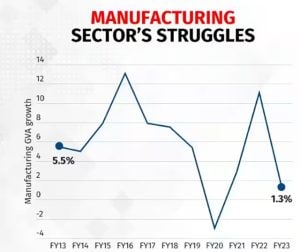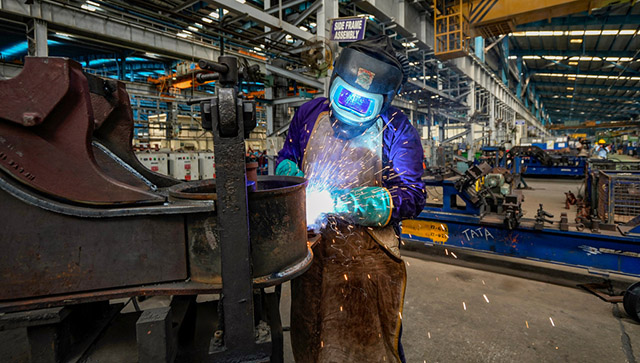Outperforming expectations, India’s GDP grew at the rate of 6.1 per cent in the last quarter of the financial year 2022-23, pushing the annual GDP growth rate to 7.2 per cent as against the earlier estimate of 7 per cent, according to the provisional national income data released by the National Statistical Office (NSO) last Wednesday. Even as India with this growth rate has cemented itself in the league of fastest growing major economies of the world, the growth seems to be largely driven by the services sector with trade and transport, financial services and construction etc. showing strong uptick. [caption id=“attachment_12693402” align=“alignnone” width=“300”] Courtesy: Moneycontrol[/caption] [caption id=“attachment_12693422” align=“alignnone” width=“300”]
 Courtesy: Moneycontrol[/caption] The Gross Value Added (GVA) growth in the manufacturing sector accelerated to 4.5 per cent year-on-year in the fourth quarter of the financial year 2022-23 as compared to 0.6 per cent a year ago, and after a dismal performance in the previous two quarters of FY 23. Moreover, the manufacturing sector seems to be struggling throughout the year with a mere GVA of 1.3 per cent. Now, let’s have a look at India, the fifth largest economy, with a ten-year average growth rate of 6.49 per cent according to the IMF. The South Asian nation is the most populous in the world (according to the UN Department of Economic Affairs), with a median age of 28.2 years (World Population Prospect) and has the largest workforce. To put it frankly, it is India’s time to showdown. Whether this double-edged sword of demographic dividend will lead towards a prospective economic boom or a lost wager is dependent on how well we cultivate the resources we have in helm. As a generic youth psychology - India dreams - dreams of becoming a $10 trillion economy by 2030 and perhaps a $20 trillion giant by 2047. But to achieve big dreams one needs to be broad in planning. Even as an economy acquires maturity and aspires to enter the age of mass consumption, the importance of the manufacturing sector can hardly be denied. Whether it may be the ‘pig-Iron’ economics of Victorian Britain, Fordism of the US, or the modern assembly lines of China, manufacturing has played its part behind the making of every economic super-giant. As the New India plans to find its rightful place in the world order and hence pursues the upcoming 25 years as an Amrit Kaal to realise the same, manufacturing sector will have to play its legit part in making of a $20 trillion economy by that time, as per an article published in The Economics Times the sector can contribute up to 22 per cent against the base prediction of 17 per cent, translating to a sector size of approximately 4.5 trillion dollars by 2047. India has a working-age population of about 800 million now, with 200 people joining the workforce in upcoming three decades, the question of employment looms large, the same article estimates that even by the conservative estimates of an output of 3.5 trillion the manufacturing sector can contribute up to 85 million jobs by 2047, the same can be the up to 90 million if the goal of $4.5 trillion manufacturing output is achieved. This can serve as a major income multiplier for the Indian economy. Further, as we move towards ‘Aatmanirbhar Bharat’ – the sector in discussion will be the flagbearer of the same – a thriving manufacturing sector can help India have more balanced trade balance, and play a major role in the global supply chain, particularly when the developed world seeks to ‘de-risk’ and ‘diversify’ its relations with China. The steps like introduction of Goods and Services Tax, enhancing Ease of Doing Business, Production Linked Subsidy scheme, and further attempts to recalibrate supply chains in India’s favour deserves appreciation in this regard. India has various sectors where it has strong growth potential like in pharmaceuticals, chemicals, automobile, textiles and apparels, moreover, the opportunities are emerging in renewables and semiconductors. Further it is the time for India to accelerate research and development spending along with investments in technology and infrastructure to support manufacturing. The target to limit logistics cost to 8 per cent of GDP by 2030 is a welcome move, and must be achieved. In this context Skill India Mission deserves a special mention, as the workforce requires quality training to meet the industry demand. This would help India tap its manufacturing potential, enhance employability, increase the living standards and facilitate domestic and foreign investments into the sector. The recent S&P Global Purchasing Managers’ Index (PMI) data has shown the silver lining as India’s manufacturing PMI rises to 31-month high. “Demand conditions demonstrated remarkable strength, with factory orders rising at the fastest pace since January 2021,” S&P Global said in a statement. It is the time for us to start building momentum. As any power that aspires to lead the world starts at least a quarter of a century before. The coming 24-25 years will be crucial to India in determining its stakes as a global political and economic power. India now needs to gear up to its highest potential, with the manufacturing sector being given a fair chance to show its charisma. Read all the Latest News , Trending News , Cricket News , Bollywood News , India News and Entertainment News here. Follow us on
Facebook,
Twitter and
Instagram.
Courtesy: Moneycontrol[/caption] The Gross Value Added (GVA) growth in the manufacturing sector accelerated to 4.5 per cent year-on-year in the fourth quarter of the financial year 2022-23 as compared to 0.6 per cent a year ago, and after a dismal performance in the previous two quarters of FY 23. Moreover, the manufacturing sector seems to be struggling throughout the year with a mere GVA of 1.3 per cent. Now, let’s have a look at India, the fifth largest economy, with a ten-year average growth rate of 6.49 per cent according to the IMF. The South Asian nation is the most populous in the world (according to the UN Department of Economic Affairs), with a median age of 28.2 years (World Population Prospect) and has the largest workforce. To put it frankly, it is India’s time to showdown. Whether this double-edged sword of demographic dividend will lead towards a prospective economic boom or a lost wager is dependent on how well we cultivate the resources we have in helm. As a generic youth psychology - India dreams - dreams of becoming a $10 trillion economy by 2030 and perhaps a $20 trillion giant by 2047. But to achieve big dreams one needs to be broad in planning. Even as an economy acquires maturity and aspires to enter the age of mass consumption, the importance of the manufacturing sector can hardly be denied. Whether it may be the ‘pig-Iron’ economics of Victorian Britain, Fordism of the US, or the modern assembly lines of China, manufacturing has played its part behind the making of every economic super-giant. As the New India plans to find its rightful place in the world order and hence pursues the upcoming 25 years as an Amrit Kaal to realise the same, manufacturing sector will have to play its legit part in making of a $20 trillion economy by that time, as per an article published in The Economics Times the sector can contribute up to 22 per cent against the base prediction of 17 per cent, translating to a sector size of approximately 4.5 trillion dollars by 2047. India has a working-age population of about 800 million now, with 200 people joining the workforce in upcoming three decades, the question of employment looms large, the same article estimates that even by the conservative estimates of an output of 3.5 trillion the manufacturing sector can contribute up to 85 million jobs by 2047, the same can be the up to 90 million if the goal of $4.5 trillion manufacturing output is achieved. This can serve as a major income multiplier for the Indian economy. Further, as we move towards ‘Aatmanirbhar Bharat’ – the sector in discussion will be the flagbearer of the same – a thriving manufacturing sector can help India have more balanced trade balance, and play a major role in the global supply chain, particularly when the developed world seeks to ‘de-risk’ and ‘diversify’ its relations with China. The steps like introduction of Goods and Services Tax, enhancing Ease of Doing Business, Production Linked Subsidy scheme, and further attempts to recalibrate supply chains in India’s favour deserves appreciation in this regard. India has various sectors where it has strong growth potential like in pharmaceuticals, chemicals, automobile, textiles and apparels, moreover, the opportunities are emerging in renewables and semiconductors. Further it is the time for India to accelerate research and development spending along with investments in technology and infrastructure to support manufacturing. The target to limit logistics cost to 8 per cent of GDP by 2030 is a welcome move, and must be achieved. In this context Skill India Mission deserves a special mention, as the workforce requires quality training to meet the industry demand. This would help India tap its manufacturing potential, enhance employability, increase the living standards and facilitate domestic and foreign investments into the sector. The recent S&P Global Purchasing Managers’ Index (PMI) data has shown the silver lining as India’s manufacturing PMI rises to 31-month high. “Demand conditions demonstrated remarkable strength, with factory orders rising at the fastest pace since January 2021,” S&P Global said in a statement. It is the time for us to start building momentum. As any power that aspires to lead the world starts at least a quarter of a century before. The coming 24-25 years will be crucial to India in determining its stakes as a global political and economic power. India now needs to gear up to its highest potential, with the manufacturing sector being given a fair chance to show its charisma. Read all the Latest News , Trending News , Cricket News , Bollywood News , India News and Entertainment News here. Follow us on
Facebook,
Twitter and
Instagram.
The coming 24-25 years will be crucial to India in determining its stakes as a global political and economic power. The fifth-largest economy now needs to gear up to its highest potential, with the manufacturing sector being given a fair chance to show its charisma
Advertisement
End of Article
Written by Vimal Harsh
Sub Editor, Opinion desk, Firstpost, Network18 see more


)

)
)
)
)
)
)
)
)



